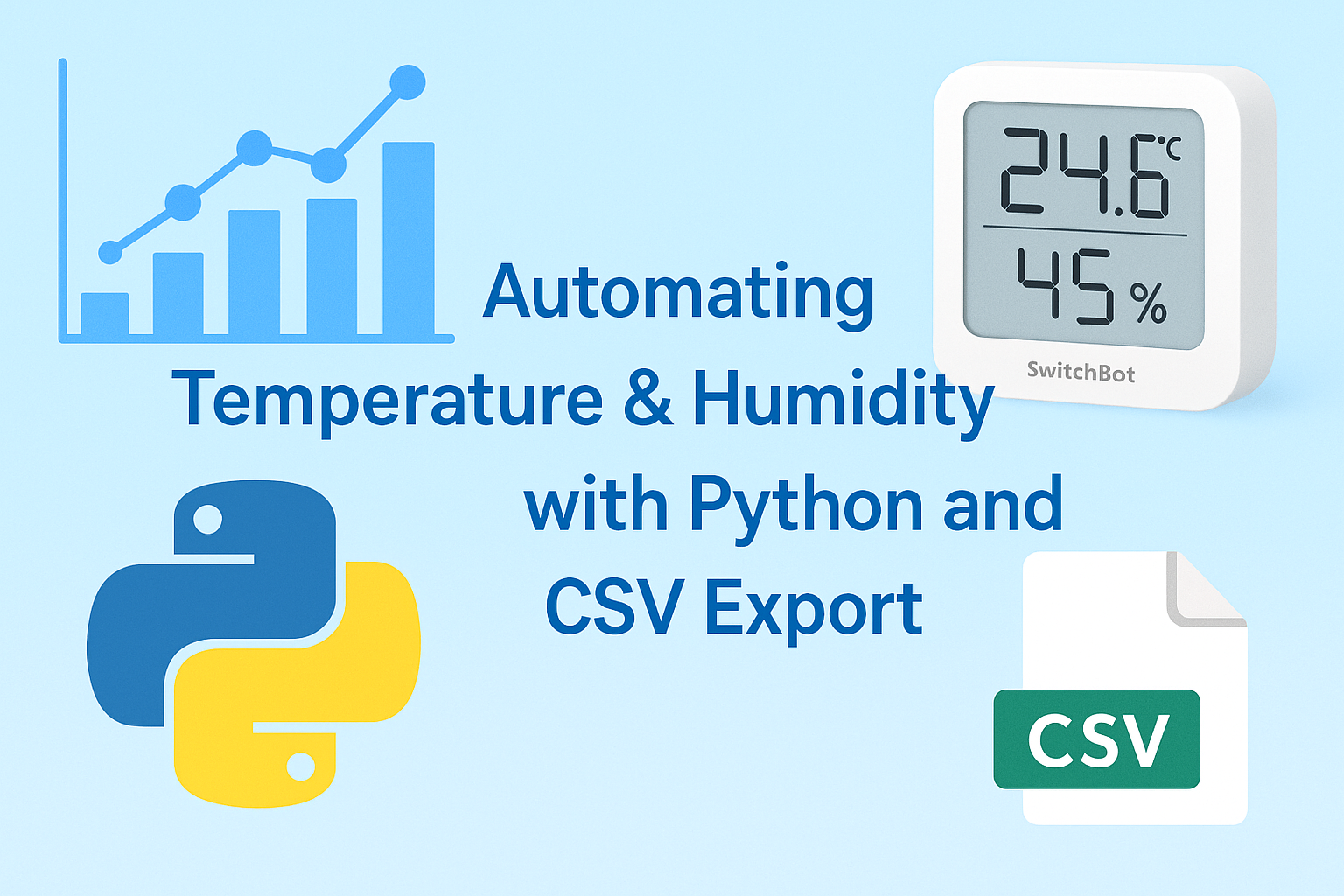Automatically Fetch and Save SwitchBot Temperature and Humidity Data Every Hour with Python [Using API]
This post is a memo-style tutorial on how to automatically retrieve temperature and humidity data from SwitchBot devices via the cloud, and log them every hour using Python.
📌 Key Features of This Method
- Utilizes the official SwitchBot API
- Supports parallel processing for multiple devices
- Compatible with Power BI and other visualization tools
- Includes duplicate record prevention logic
💡 Requirements & Setup
- SwitchBot Temperature and Humidity Meter + Hub
- SwitchBot API token
- Python 3.8 or higher (Windows/Linux)
- Device IDs and a folder path for saving CSV files
💻 Full Python Script (with dummy values)
The following code collects temperature and humidity data every hour and appends it to CSV files with duplicate check logic:
import requests
import csv
import time
import os
import shutil
from datetime import datetime
import multiprocessing
API_TOKEN = os.getenv("SWITCHBOT_API_TOKEN")
DEVICE_INFO = {
'AAAAAAAAAA': 'aaaa.csv',
'BBBBBBBBBB': 'bbbb.csv',
'CCCCCCCCCC': 'cccc.csv',
'DDDDDDDDDD': 'dddd.csv',
}
URL_TEMPLATE = 'https://api.switch-bot.com/v1.0/devices/{}/status'
HEADERS = {
'Authorization': API_TOKEN,
'Content-Type': 'application/json; charset=utf8'
}
SOURCE_FOLDER = './data'
DESTINATION_FOLDER = './data'
def get_temperature_humidity(device_id):
url = URL_TEMPLATE.format(device_id)
response = requests.get(url, headers=HEADERS)
data = response.json()
temperature = data['body']['temperature']
humidity = data['body']['humidity']
return temperature, humidity
def read_last_two_timestamps(filename):
last_two = []
if os.path.exists(filename):
with open(filename, 'r', newline='') as file:
reader = csv.reader(file)
next(reader)
for row in reader:
last_two.append(row[0])
return last_two[-2:]
def save_to_csv(device_id, temperature, humidity):
now = datetime.now().replace(minute=0, second=0, microsecond=0)
timestamp = now.strftime('%Y-%m-%d %H:%M:%S')
filename = f'temperature_humidity_data_{device_id}.csv'
file_path = os.path.join(SOURCE_FOLDER, filename)
file_exists = os.path.isfile(file_path)
with open(file_path, mode='a', newline='') as file:
writer = csv.writer(file)
if not file_exists:
writer.writerow(['Timestamp', 'Temperature (°C)', 'Humidity (%)'])
writer.writerow([timestamp, temperature, humidity])
copy_csv(filename, DEVICE_INFO[device_id])
last_two = read_last_two_timestamps(file_path)
if len(last_two) == 2 and last_two[0] == last_two[1]:
remove_last_row(file_path)
copied_file_path = os.path.join(DESTINATION_FOLDER, DEVICE_INFO[device_id])
last_two_copied = read_last_two_timestamps(copied_file_path)
if len(last_two_copied) == 2 and last_two_copied[0] == last_two_copied[1]:
remove_last_row(copied_file_path)
def copy_csv(source_filename, destination_filename):
if not os.path.exists(DESTINATION_FOLDER):
os.makedirs(DESTINATION_FOLDER)
shutil.copy(
os.path.join(SOURCE_FOLDER, source_filename),
os.path.join(DESTINATION_FOLDER, destination_filename)
)
def remove_last_row(filename):
with open(filename, 'r+', newline='') as file:
lines = file.readlines()
file.seek(0)
file.writelines(lines[:-1])
file.truncate()
def process_device(device_id):
while True:
try:
temperature, humidity = get_temperature_humidity(device_id)
save_to_csv(device_id, temperature, humidity)
print(f'{device_id}: {temperature}°C, {humidity}% saved at {datetime.now()}')
except Exception as e:
print(f'Error ({device_id}): {e}')
time.sleep(3600)
def main():
processes = []
for device_id in DEVICE_INFO.keys():
p = multiprocessing.Process(target=process_device, args=(device_id,))
processes.append(p)
p.start()
for p in processes:
p.join()
if __name__ == '__main__':
main()🔐 Security & Privacy Notes
Replace the following placeholders with your actual settings:
| Placeholder | Description |
|---|---|
os.getenv("SWITCHBOT_API_TOKEN") | Your SwitchBot API token |
'AAAAAAAAAA' etc. | Your individual device IDs |
'aaaa.csv' etc. | Your target CSV file names |
📊 Visualization Ideas & Applications
Run on a Raspberry Pi or similar device for 24/7 tracking
Load the CSV data into Power BI Desktop for visualization
Sync to Google Sheets for cloud-based monitoring
Monitor multiple rooms in your home simultaneously

